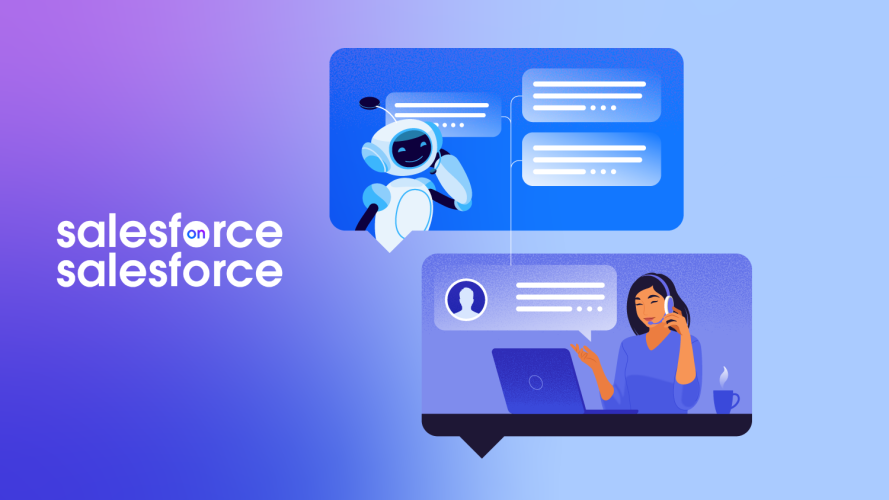100 Million Missed Opportunities Later, We Found a Better Way To Sell

There's not enough manpower, or hours in the day, to follow up on the thousands of sales prospects coming onto our radar every day. Agentforce changed the game.
Key Takeaways
Sales teams are always chasing more leads, but even the best reps are limited by the clock. There simply aren’t enough hours in the day to follow up on every prospect, which means countless leads and potential deals fall through the cracks; opportunities that are too small, premature, or too numerous fail to get the attention they deserve.
This was the case at Salesforce, where CEO Marc Benioff estimated that about 100 million sales leads have gone unanswered over the past quarter century. “We just couldn’t call them back because we didn’t have enough people,” he said. Now, as an agentic enterprise, Salesforce is using AI sales agents to automate outreach, lead qualification, and follow-ups, and to book meetings. The result? A scalable system that makes sure no lead ever goes cold again.
In July, we started using Agentforce to augment our sales teams. An agent autonomously follows up on every lead and turns them into opportunities. The results were nearly immediate and tangible. As of October 1:
- 68,000 leads have been newly analyzed and re-engaged,
- 156,000 emails have been sent, 94,000 opened, and 2,400 replied to,
- 800 meetings have been autonomously booked, and
- dozens of deals have closed.
Here’s why we created an agent for our team, how we did it, and what we’ve learned.
Why Salesforce created its own sales agent
It’s simple: Salesforce was leaving business on the table. Historically, only one in four sales leads were followed up on. The rest were ignored because they scored too low to justify human outreach.
Lead scoring is a common sales process that assigns a value to prospects based on their demographics, behavior, and sales readiness. It’s a necessary but sometimes flawed way to prioritize a sales team’s limited time. Designed to focus on the most obvious, high-scoring leads, it can overlook hidden opportunities, leads that may seem low-quality on the surface but are actually strong prospects.
The other reason leads were ignored was even more practical. There are a finite number of sales development reps (SDRs) — about 400 — at Salesforce, and millions of leads show up on our radar each year.
“Every day there are tens of thousands of people who come to our website and fill out a form,” said Vanessa Tabbert, senior director of sales development at Salesforce. “We could never scale enough humans to do that level of outreach.”
How the sales agent works
Salesforce is Customer Zero for many new technologies, which means we pilot our own technology companywide, gathering insights and sharing best practices with customers.
Agentforce is a digital extension of your sales team. You give it its own account and the right permissions, and, following rules of engagement and opt-out preferences, it works around the clock on a schedule you set.
Scale effortlessly with Agentforce
Watch Agentforce in action, and discover how to retool for growth with AI-augmented sales.



Once a prospect is assigned to the agent, it automatically adds them to a series of email outreach steps. The agent then takes over, sending customized emails based on what it knows about the prospect. All of this agent activity appears in the lead’s activity history so your human reps always have a full, clear picture.
The agent generates a personalized initial email based on a prospect’s record details. This information is gathered when someone fills out a web form, attends an event, or registers for a webinar or demo.
If the prospect doesn’t respond, the agent sends a follow-up. If they do reply, the agent identifies their interest level, sends a response containing a meeting link, and copies the human sales rep.
If a prospect asks a question, the agent provides answers generated from product or customer service documentation uploaded in Agent Builder, a tool that lets you build and deploy agents without writing code.
A critical step is feeding the agent with relevant information so it can communicate with the prospect most effectively and in the organization’s voice and tone. This became a foundational commitment for the entire project. It meant viewing the underlying data infrastructure as the true key to the agent’s success.
“We needed to invest more in our data strategy,” said Jenny Tran, senior director of product management, sales and AI agents, at Salesforce. “All the content ingested into Agentforce is from CRM and Data 360.”
Join the Salesblazer movement
We’re building the largest and most successful community of sales professionals, so you can learn, connect, and grow.

By using Data 360 to unify all company data (such as past purchases, support history, and website activity), the agent can see the complete story of the prospect. It can then personalize every interaction, from the tone of an email to the details of the solution it offers.
What we learned
One important thing we learned is that the out-of-the-box email prompts we initially used were too generic to be useful for most prospects. They didn’t reflect a prospect’s specific interest — say, if they asked about a particular product.
Now, the email prompts are customized to be more detailed, grounded in data from trusted company information like product guides. This grounds the AI, allowing it to write an answer that is on point and aligned with the company’s official voice.
“The real unlock is the investment in the prompts and the tuning of this agent — because that is the only way to make it more personalized,” said Tran. “Turning the agent on and configuring it is super easy. The hard work is figuring out what content we want the agent to impart, determining the tone of the email, and how to align it with Salesforce culture and messaging.”
The team is continuing to A/B test and enhance email prompts to make communication as personalized as possible.
Another key takeaway is the importance of transparency — a key component of building trust in the AI era. From the start, every email to a prospect stated up front that it was coming from Agentforce.
“We’re not trying to trick anybody or make anybody think that it’s a human,” said Tabbert, adding that most prospects had a positive reaction to the AI outreach.
Other revelations:
- Agents can revisit cold leads at scale, finding revenue without burdening reps.
- Persistent but respectful outreach from agents increases the likelihood of scheduling a meeting.
- We moved beyond simple activity counts to measure real business outcomes, like pipeline generated, meetings booked, and opportunities created.
- Emails from the agent have higher engagement levels than human-written ones.
- The best results come when agents focus on scaling the work, and humans focus on more complex, relationship-driven deals.
What’s next?
Working with our first agent has taught us a lot. We’ve seen how small things like better prompts can make a big difference, and how important it is to keep communication open and clear. Having humans in the loop has proven essential, helping us get real results without losing trust. But we’re still early in the process. The real challenge now is to take what we’ve learned and push further to make the agent a sharper, more reliable, and even stronger partner for our salespeople.
The teams will continue to refine, test, and tune the email prompts based on data, for better personalization and accuracy.
Tabbert said the company is also creating a hybrid role where a human SDR is paired with an SDR agent. “Instead of overseeing 500 leads a month, they’ll oversee 15,000, because the agent will do most of the outreach,” she said.
Ultimately, all of this refinement, collaboration, and automation is driven by a single, high-stakes business imperative: to operate with speed, scale, and efficiency. Tabbert said it’s crucial to contact a lead very quickly to stand a chance at converting them to a customer.
“We know when people come to our website, they’re going to our competitors’, as well. The majority of the time, the first person to connect with that prospect is the one who’s going to win that deal.”
With the agent, we’re contacting prospects within just a few minutes.
For years, we watched good opportunities slip away because our system couldn’t keep up. What once sat idle for months can now be turned into a real conversation before your coffee gets cold. Moving at that speed and scale is what transforms a bottleneck into a breakthrough.
What’s your agentic AI strategy?
Our playbook is your free guide to becoming an agentic enterprise. Learn about use cases, deployment, and AI skills, and download interactive worksheets for your team.


























